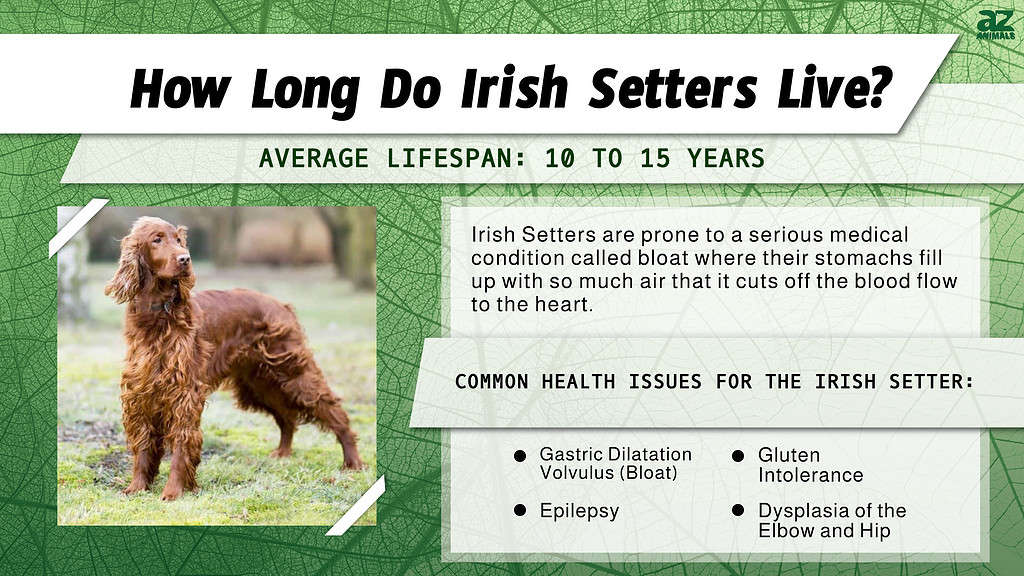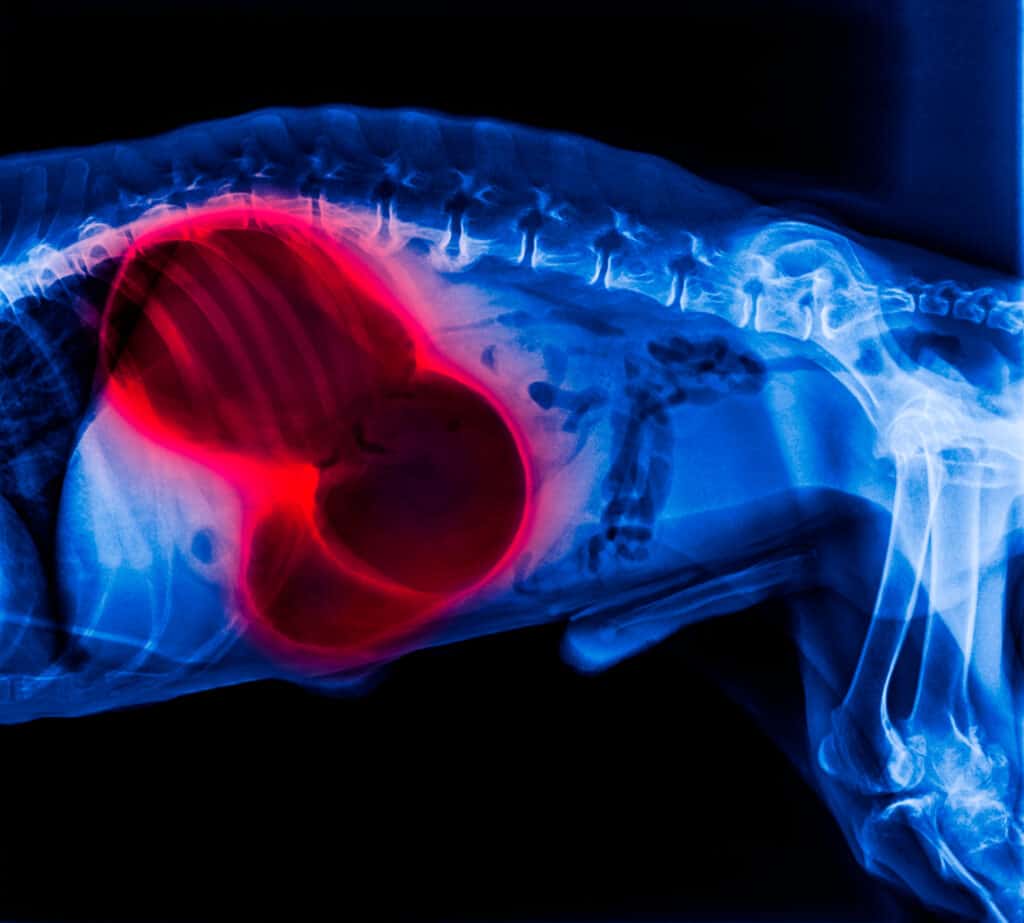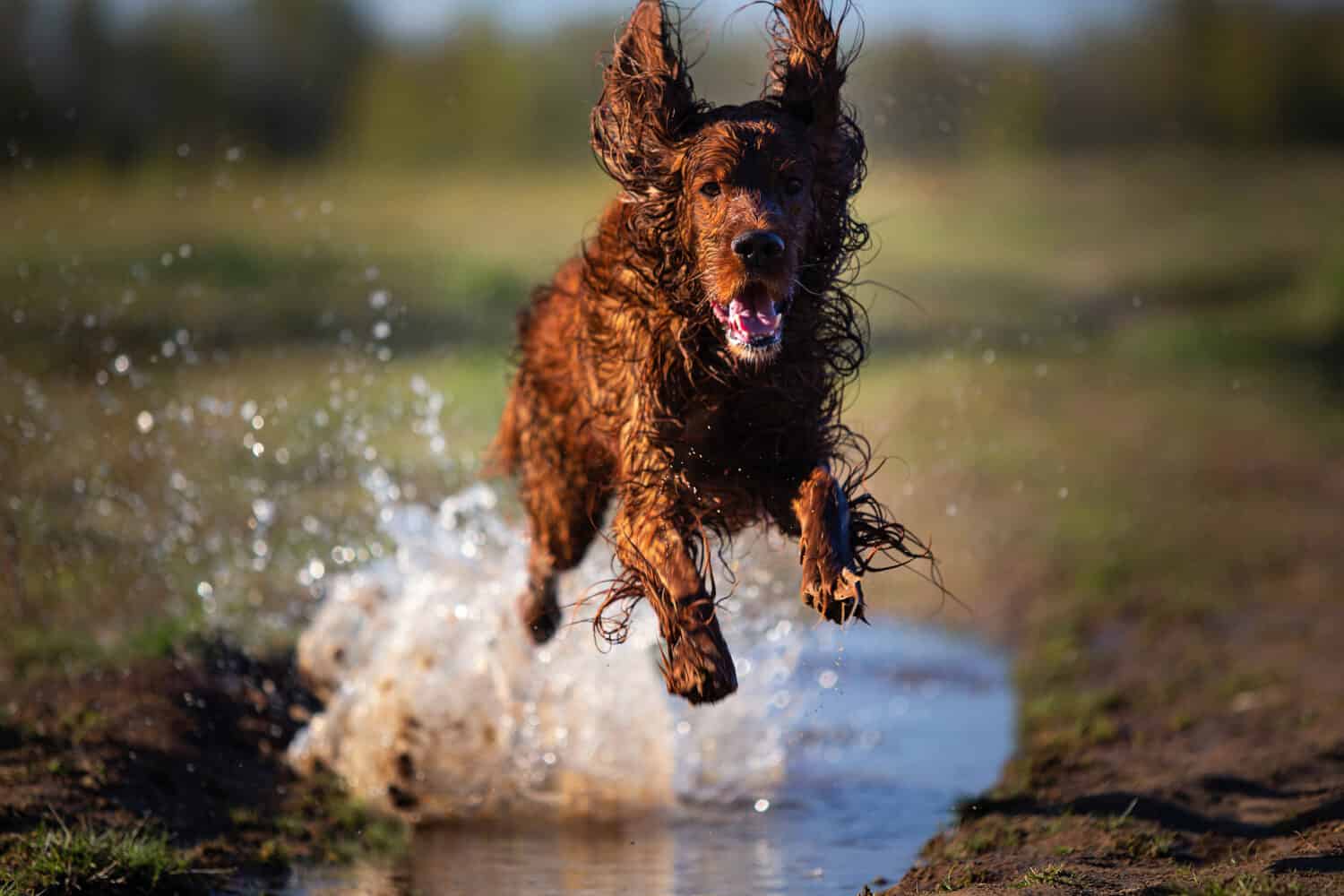
A popular gun dog, the Irish setter is prized for its intelligence, playfulness, loving disposition, and unusual beauty. Their long, silken, red mahogany coat with glorious feathering on the legs, chest, ears, and tail distinguishes them from other large breeds. They originated in Ireland, hence their name. But there’s another reason they are called Irish setters: these dogs crouch when locating game. Other dogs are named for their ability to retrieve or point, but Irish setters can do both. Their gorgeous red coat is not only beautiful, but it protects them from bad weather and chilly water that often comes with hunting game birds and waterfowl.
Factors That Affect an Irish Setter’s Lifespan

This adorable Irish setter puppy should live about 12 years.
©Sheleh Vadzim/Shutterstock.com
Though Irish setters are hardy dogs, several factors can affect how long they live. They include:
Health Issues
One of the most common Irish setter health issues is a tendency to bloat, also called gastric dilatation volvulus. This occurs when the dog’s stomach fills up with so much air that it cuts off the blood flow to the heart. This is, of course, a medical emergency. Irish setters are also at some risk of epilepsy, gluten intolerance, rashes, and dysplasia of the elbow and hip. They are also prone to some eye problems and ear infections. Luckily, some of these problems, such as rashes and ear infections, can be prevented by good grooming. Adopting your Irish setter puppy from a reputable breeder helps lower the risk of health problems.

This X-ray of a dog highlights gastric dilatation volvulus (GDV).
©Intarapong/Shutterstock.com
Exercise
This dog was bred to get plenty of exercise and won’t do well cooped up in an apartment. Aside from daily walks, they need space to simply run around and play. An Irish setter that doesn’t get plenty of exercise becomes anxious and hard to handle.

Play and exercise are essential for a happy, healthy Irish setter.
©Ksenia Raykova/Shutterstock.com
Whether They’re Spayed or Neutered
Dogs that are spayed or neutered live longer than those that are not. These fairly simple procedures reduce the dog’s chance of getting reproductive cancers and other disorders. Unless you really intend to show your dog, you should have it “fixed.”
Diet
To avoid bloat, your Irish setter should be fed two or three small meals throughout the day. The meals should be gluten-free to avoid problems that come with possible gluten intolerance. There are different types of dog food on the market to fulfill the needs of Irish setter puppies, young adults, and senior dogs.
Whether They’re an Indoor or Outdoor Dog
Irish setters are divided into show lines and field lines. Field line dogs are bred to hunt and participate in field trials, but even these dogs shouldn’t be kept permanently outdoors. Dogs that live outdoors don’t live as long as dogs that live indoors. Outdoor dogs are subject to the weather, accidents, and diseases. If your dog isn’t kept in a protective pen or a fenced yard, it may get into fights with other dogs or other types of animals. Additionally, outdoor dogs that are not spayed or neutered will find a way to mate. An Irish setter’s coat is also more likely to become dirty and matted if it’s kept outside all the time. This means more work for you when it comes to daily grooming.

Irish setters tend to love spending time outside.
©Alex Zotov/Shutterstock.com
Level of Firm, Loving Discipline
You’ll need to exercise calm and loving authority over a dog as sprightly as an Irish setter. Dealing with your dog harshly will make her skittish and not eager to obey. Daily grooming of her beautiful coat and lots of physical and mental exercise also go a long way in building a good relationship with an Irish setter. A happy, healthy dog tends to live longer than one that is constantly stressed.
Signs Your Dog is Getting Older

An older Irish setter may want to take it easy instead of play.
©DragoNika/Shutterstock.com
Unlike with humans, it’s hard to tell the age of a grown dog at a glance. After all, dogs don’t develop wrinkles as they age. Their coats don’t turn completely gray, though you may see a few stray gray hairs here and there. As with a horse, one physical sign that a dog is older is the condition of his teeth. An old dog’s teeth may have accumulated lots of tartar and show signs of wear. The dog may even have teeth that are chipped or missing. His eyes may turn cloudy, and he may lose muscle tone. But it’s the dog’s behavior that really tells his age.
Irish setter puppies and young adults are known for their high energy levels. As they age, they slow down and don’t want to play or run around as much. Like old people, they’ll sometimes prefer taking a nap to chasing a ball. Make sure your dog’s bed is soft, supportive, and kept out of drafts and direct sunlight. Older dogs are also subject to arthritis, and your pup may develop stiff joints that make even walking uncomfortable. Vets recommend laying down textured mats or runners over slippery floors to help with balance and joint pain. It’s also a good idea to keep needful objects near your dog’s bed, such as food, water, and toys. Your aging Irish setter may also need to go to the bathroom more often and may even become a little incontinent.
Keeping Your Dog Comfortable
There are many ways you can keep an older Irish setter comfortable in old age. Take her for short but frequent walks. This provides exercise and keeps her up to date on what’s happening in the neighborhood via the “pee mail.” Lots of toys keep her interested, and gently brushing and combing her fur encourages bonding and also lets you check for lumps, bruises, and sore spots. It’s also a good time to trim your dog’s nails if they’ve grown too long. If you don’t trust yourself to do this, have the vet do it.
Old dogs don’t hear or see as well as they used to, so don’t be alarmed if your dog doesn’t come right away when you call or rush into a room like he used to when you open a bag of bacon bits. Though you don’t have to tiptoe around your home, try to avoid bangs, crashes, and other loud noises that might startle your dog.
When the End is Near
Inevitably, the end will come, and there are signs to look for. Your dog may be in obvious pain or discomfort, and you’ll need to talk to your vet about your options. These may include pain meds and, yes, euthanasia. An uncomfortable dog will sleep more or grow restless. If he’s in actual pain, he will also try to hide. You may see him trembling, panting, crying, or whining. He may even try to bite when you approach.
Another sign that your dog’s life is coming to an end is loss of appetite. You may notice that he is losing weight at an alarming rate, either because he has stopped eating or his metabolism is off. Your Irish setter will start to lose interest in the things that used to give him pleasure, like toys. He may grow lethargic and even depressed. Your pup may vomit or become incontinent as his digestive system shuts down. It’s up to you to give your dog water so he doesn’t become dehydrated and to make sure that his body and bedding are kept clean.
You’ll also notice that your dog smells different. This can be due to incontinence or other changes in metabolism caused by the death process. His eyes may grow dull and sunken, and his temperature may fluctuate as physical processes start to fail.
You may opt to take care of your dog at home until he passes. And you may be forced to end his suffering. Nowadays, you don’t have to take your dog to the vet to do so. A professional can come and do the job while your dog rests in his own home, surrounded by loved ones.
Lastly, don’t hesitate to take the time you need to grieve your beloved family member.
The photo featured at the top of this post is © Alex Zotov/Shutterstock.com
Thank you for reading! Have some feedback for us? Contact the AZ Animals editorial team.






